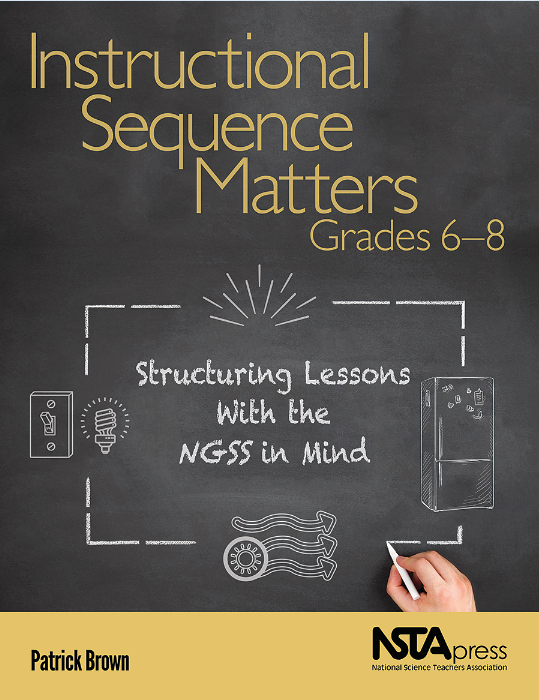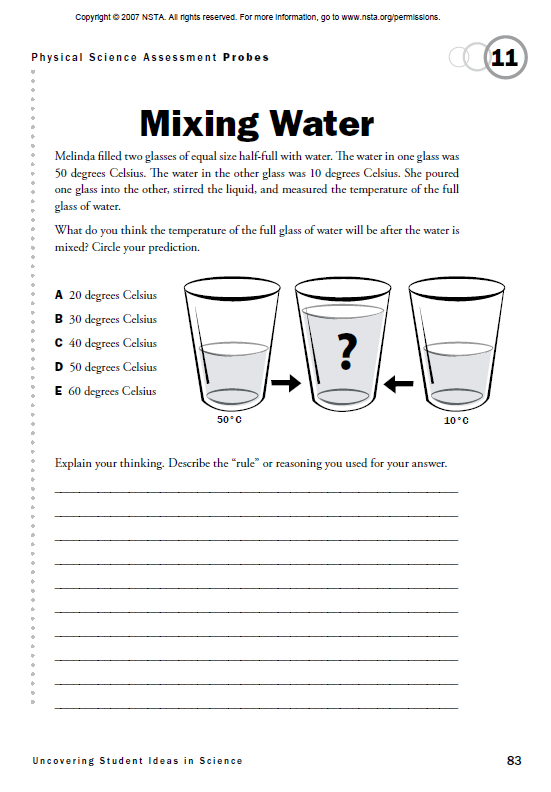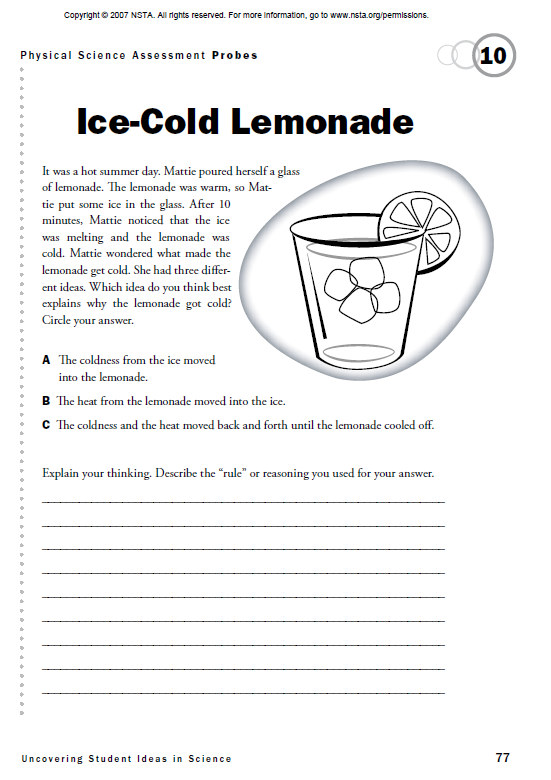Middle School Elementary Informal Education | Daily Do
Why Are the Temperatures Changing?

Crosscutting Concepts Disciplinary Core Ideas Is Lesson Plan NGSS Phenomena Physical Science Science and Engineering Practices Three-Dimensional Learning Middle School Elementary Informal Education Grade 4 Grades 6-8
Sensemaking Checklist




Welcome to NSTA's Daily Do
Teachers and families across the country are facing a new reality of providing opportunities for students to do science through distance and home learning. The Daily Do is one of the ways NSTA is supporting teachers and families with this endeavor. Each weekday, NSTA will share a sensemaking task teachers and families can use to engage their students in authentic, relevant science learning. We encourage families to make time for family science learning (science is a social process!) and are dedicated to helping students and their families find balance between learning science and the day-to-day responsibilities they have to stay healthy and safe.
Interested in learning about other ways NSTA is supporting teachers and families? Visit the NSTA homepage.
What Is Sensemaking?
Sensemaking is actively trying to figure out how the world works (science) or how to design solutions to problems (engineering). Students do science and engineering through the science and engineering practices. Engaging in these practices necessitates that students be part of a learning community to be able to share ideas, evaluate competing ideas, give and receive critique, and reach consensus. Whether this community of learners is made up of classmates or family members, students and adults build and refine science and engineering knowledge together.
Introduction
Energy transfer can be a confusing subject for students and adults because of the way we commonly talk about hot and cold "moving" in our daily environments. In today's task, Why is the temperature changing?, students and their families engage in science and engineering practices to begin to make sense of the science idea that energy (motion) is transferred from hotter (faster-moving particles) areas to cooler (slowly-moving particles) areas. By working together, parents, teachers, and students can create a dialogue about energy transfer that is grounded in evidence.
This task is adapted from Instructional Sequence Matters, Grades 6–8: Structuring Lessons With the NGSS in Mind and Instructional Sequence Matters, Grades 3–5: Explore Before Explain, by Patrick Brown, published by NSTA Press.

Daily Do Playlist: Transfer of Thermal Energy (Heat)
Why are the temperatures changing? is a stand-alone task. However, it can be taught as part of an instructional sequence in which students coherently build science ideas about the spontaneous transfer of thermal energy from hotter regions or objects into colder ones.
Engage

Begin by having students predict what will happen when two half-full containers of water at different temperatures are mixed. The Mixing Water formative assessment probe at right form Uncovering Student Ideas in Science, Volume 2, is perfect to use for the Engage phase.
The Uncovering Student Ideas in Science, Volume 2, authors suggest modifying the prediction choices for younger students: (1) the water will become even cooler, (2) the water will become even warmer, or (3) the water will be somewhere between the two.
Consider asking students to model the water in the three cups. They might do this on the back of the probe or on blank paper. Suggest to students that they use a circle or some other symbol to represent the water particles (molecules) in the containers. What is the difference between a "cold" water particle and "hot" water particle? How are the water particles interacting in each cup? How would students represent water particles in the middle container to explain their prediction?
Explore, Part 1
During the Explore phase, students collect data to help them confirm, refute, or refine their scientific ideas. Students can explore the phenomenon at home using everyday materials or in a classroom setting.
Materials
- thermometer (meat thermometer, aquarium strip thermometer, temperature probe, etc.)
- three containers (one container should be slightly larger than the other two)
- hot and cold water (Make sure the temperatures can be measured with the thermometer students are using: A meat thermometer or aquarium strip thermometer likely won't be able to record the temperature of ice-cold water.)
The At-Home Investigation is conducted using a meat thermometer, available containers, hot tap water and cold water from the refrigerator. The In-Class Investigation uses glass beakers, a temperature probe, and hot tap and refrigerated water.
Conduct the Investigation
- Fill one container about half full with hot tap water, then fill a second container with cold water.
- Measure and record the temperature of water in each container.
- Pour the hot water and cold water into the third container. Gently mix them together.
- Measure and record the temperature of the water in the third container.
Ask students, "What do you think would happen if we repeated this investigation, but used hot water and cold water with different starting temperatures? Why do you say so?"
Repeat the investigation two more times, each time using hot and cold water with different starting temperatures than in the previous investigation (be aware of the limits of the thermometers students are using). Students might want to try using hot and cold water with really big temperature differences, really small temperature differences, or temperatures that are both hot (really hot vs hot) or both cold (cold vs really cold).
Ask students, "What patterns do you notice in our temperature data?" (The temperature of the water in the third container is always between the hot water and cold water temperature; the water temperature in the third container is always the average of the hot water and cold water temperatures.)
Ask students to return to the model they drew on the Mixing Water formative assessment probe (or other paper). What would they add to their model? What would they change? Why? Alternatively, ask students to revise their initial model using this scaffold.
Explore, Part 2

The second exploration targets exploring the direction of thermal energy transfer. You can use the Ice-Cold Lemonade formative assessment probe from Uncovering Student Ideas in Science, Volume 2, for the Explore phase (at left). Have students discuss their predictions and provide a reason to support their thinking.
As before, you can explore the phenomenon at home using everyday materials or in a classroom setting.
Materials
- large glass pitcher or beaker
- empty travel-sized liquid container (mouthwash, nail polish, shampoo, etc.)
- red and blue food coloring
- hot and cold water
- string (about 8–12 inches long)
Guide students in setting up the first of two investigations. You can see what the setup should look like in the At-Home Investigation video.
Investigation 1
- Tie a string around the empty travel-sized container. The string will be used to lower the travel-sized container into the glass pitcher.
- Pour cold water into the travel-sized container. Add a few drops of blue food coloring.
- Pour hot water into the glass pitcher. (Do not add food coloring.)
- Slowly lower the travel-sized container filled with blue, cold water into the pitcher with hot water. Gently set the travel-sized container on the bottom of the pitcher, being careful to keep the container upright.
- Ask students to observe what is happening in the pitcher for at least two minutes.
After students have recorded their observations using words and pictures, empty both the pitcher and travel-sized containers. Make sure to rinse out the travel-sized container. Guide students in setting up the second investigation (again, you can see the setup in the At-Home Investigation video).
Investigation 2
- Make sure the string is tightly tied to the travel-sized container.
- Pour hot water into the travel-sized container. Add a few drops of red food coloring.
- Pour cold water into the large pitcher. (Do not add food coloring.)
- Slowly lower the travel-sized container filled with red hot water into the pitcher filled with cold water. Gently set the travel-sized container on the bottom of the pitcher, being careful to keep the container upright.
- Ask students to observe what is happening in the pitcher for at least two minutes.
(Note: The In-Class Investigation replaces the travel-size container with a small Erlenmeyer flask and replaces the glass pitcher with a large beaker.)
The investigation allows students to visualize the transfer of (motion) energy, which otherwise is not easily observable. To many students’ surprise, energy (motion) transfers in only one direction, from hot areas to cold areas.
Alone Zone. Give student independent thinking time to add to/change their model based on the observations they made in this investigation.
Partner or Small Group. Ask students to share what they added to or changed on their model based on their new observations. Consider using these partner conversational supports:
Speaker: I think ____ because _____.
Responder: I heard you say ______. (honors speaker) One difference between my idea and yours is...
Explain
With these experiences in mind, students can begin to form a deeper conceptual understanding of thermal energy and the transfer of thermal energy and be able to apply their ideas in different circumstances. You might ask students use gestures or "act out" the movement of hot and cold water molecules using their whole body to represent water particles (molecules), or the tip of each finger might represent a single water particle (molecule). Water particles representing hot water should move faster compared to water particles representing cold water.
Student can also model energy being transferred from hot water to cold water. Fast-moving water particles (molecules) can transfer their motion energy to slower-moving water particles through (gentle!) collisions until all water particles are moving at the same speed.
After all that movement and fun exploring thermal energy transfer, it will probably be time for a nice cold drink of water—or sip of hot tea!
NSTA Collection of Resources for Today's Daily Do
NSTA has created a Why is the temperature changing? collection of resources to support teachers and families using this task. If you're an NSTA member, you can add this collection to your library by clicking Add to My Library, located near the top of the page (at right in the blue box).
Check Out Previous Daily Dos From NSTA
The NSTA Daily Do is an open educational resource (OER) and can be used by educators and families providing students distance and home science learning. Access the entire collection of NSTA Daily Dos.
Acknowledgments
Mixing Water and Ice-Cold Lemonade are published in the NSTA Press book Uncovering Student Ideas in Science, Volume 2: 25 More Formative Assessment Probes.

